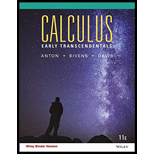
The formula obtained in part (b) of Exercise 43 is useful in
Use the transformation
Want to see the full answer?
Check out a sample textbook solution
Chapter 14 Solutions
CALCULUS EARLY TRANSCENDENTALS W/ WILE
Additional Math Textbook Solutions
Glencoe Math Accelerated, Student Edition
Precalculus
Calculus: Single And Multivariable
Calculus & Its Applications (14th Edition)
Calculus 2012 Student Edition (by Finney/Demana/Waits/Kennedy)
University Calculus: Early Transcendentals (4th Edition)
- a) Suppose you are given model with two explanatory variables such that: Y₁ = a + B₁x₁i + B₂x₂₁x + u₁, i = 1,2,...n Using partial differentiation derive expressions for the expressions for the intercept and slope coefficients for the model above.arrow_forwardshow that the L operator is linear for y" – 4y" + 2y' +y = x?arrow_forwardTransform the equation: 2x2y'' + xy' + 3y = 0 to the form of: a(d2y/dz2) + b(dy/dz) + cy = 0 (a, b, c) = a) (2,1,-3) b) (2,-1,3) c) (-2,1,4) d) (2,-1,4) e) (2,0,0)arrow_forward
- do b) d) f) H)arrow_forwardThe complex function f(z)=u(x,y)+iv(x,y) can be differentiated at any point in the complex space. The real part of this function is given as u(x,y)=e−x[xsin(y)−ycos(y)].Determine the derivative of the function f(z) at z=i.arrow_forwardFind a direction in the xy-plane in which f(x, y) = e¹-² has zero change at the point P(1,0, e). -xyarrow_forward
- Find the scalar equation for the plane passing through the point P=(−1, 5, 0) and containing the line L defined by x = −3+5t y = 3+2t z = −5+t 0=0arrow_forward(a) Find the direction for which the directional derivative of the function f(x, y, z)=√x² + y² + z² is a maximum at P = (8,5, 2). (Use symbolic notation and fractions where needed. Give your answer in vector form.)arrow_forwardShow that t, e^t, and sin(t) are linearly independent.arrow_forward
- Please use neat notation for the matrices to make your solution easier to understand. It's much appreciated :)arrow_forwardCompute ∇ƒ(-1, 2, 1), where ƒ(x, y, z) = xy/z.arrow_forwardFind the scalar equation for the plane passing through the point P=(-5, 3, 2) and containing the line L defined by x = −7+6t y = −2+4t Z=-2 0=0arrow_forward
 Calculus: Early TranscendentalsCalculusISBN:9781285741550Author:James StewartPublisher:Cengage Learning
Calculus: Early TranscendentalsCalculusISBN:9781285741550Author:James StewartPublisher:Cengage Learning Thomas' Calculus (14th Edition)CalculusISBN:9780134438986Author:Joel R. Hass, Christopher E. Heil, Maurice D. WeirPublisher:PEARSON
Thomas' Calculus (14th Edition)CalculusISBN:9780134438986Author:Joel R. Hass, Christopher E. Heil, Maurice D. WeirPublisher:PEARSON Calculus: Early Transcendentals (3rd Edition)CalculusISBN:9780134763644Author:William L. Briggs, Lyle Cochran, Bernard Gillett, Eric SchulzPublisher:PEARSON
Calculus: Early Transcendentals (3rd Edition)CalculusISBN:9780134763644Author:William L. Briggs, Lyle Cochran, Bernard Gillett, Eric SchulzPublisher:PEARSON Calculus: Early TranscendentalsCalculusISBN:9781319050740Author:Jon Rogawski, Colin Adams, Robert FranzosaPublisher:W. H. Freeman
Calculus: Early TranscendentalsCalculusISBN:9781319050740Author:Jon Rogawski, Colin Adams, Robert FranzosaPublisher:W. H. Freeman
 Calculus: Early Transcendental FunctionsCalculusISBN:9781337552516Author:Ron Larson, Bruce H. EdwardsPublisher:Cengage Learning
Calculus: Early Transcendental FunctionsCalculusISBN:9781337552516Author:Ron Larson, Bruce H. EdwardsPublisher:Cengage Learning





